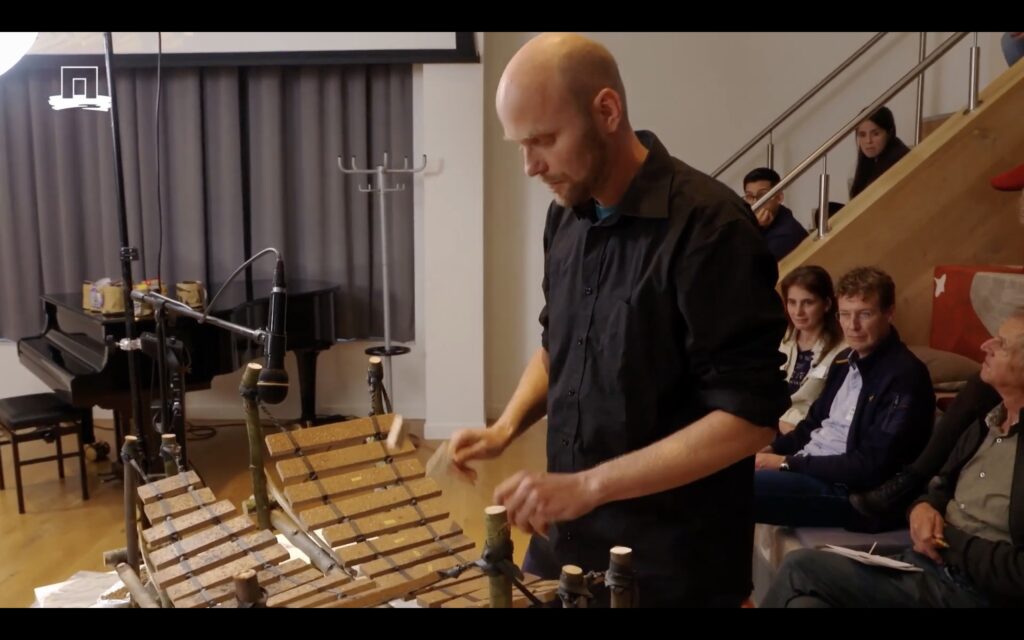De Bovifoon (koeienklank) en aqualentifoon (waterlinzen oftewel eendekroos klank), gaan te horen en te zien zijn bij de Dutch Design Week in Eindhoven op de locatie Bio Art Laboratories, voor de klokhuiskijkers onder u bekend van de afleveringen over biokunstenares Jalila Essaidi. Adres: Oirschotsedijk 14-10, Eindhoven, dagelijks open van 11-17uur, van 22 tot 30 oktober. (voer in navigatie/google maps liever het coordinaat 51.46357051165881, 5.428970802426011 in of “Bio Art Laboratories” in plaats van het adres, want met het adres kom je met de meeste navigatiehulpen fout uit. De juiste ingang van Bio Art Labs is schuin tegenover de Philips fruittuin.)
de bovifoon en aqualentifoon waren te horen op de Alumnidag van de Wageningen Universiteit op 8 oktober 2022 in een talkshow. Deze vind je door op de afbeelding hierboven te klikken en dan weet je hoe de instrumenten klinken.
Maar waarom maakt een kunstenaar een instrument van koeienbloed en probeert deze vervolgens na te maken van verschillende plantaardige alternatieven, om uiteindelijk met een instrument gemaakt van eendekroos op tour te gaan? Dat kun je hieronder lezen in de tekst bij het werk in de expositie van de Dutch Design week:
Boviphone & Aqualentiphone – by Remco de Kluizenaar, Sound-Artist
(artist in residence 2021-22 at Wageningen university and Research)
“Have you considered eating cows blood and waterlentils yet?”
These two instruments are meant as an audible analogy to the research of Wageningen University and Research in replacing animal proteins by plant proteins in food. The “kipstuckjes” of the Vegetarian Butcher are a famous example of an “edible novel material” from WUR research. Milk with the actual cow protein casein, but made by yeast, will follow in some years.
For the firstly built instrument the material “Bois Durci” (patent Paris 1865) was reinvented to make soundbars. The instrument is called Boviphone (cow sound) because Bois Durci is an early bioplastic made from cows blood and sawdust (a waste stream from the Paris slaughterhouses back then). We used palo santo (holy wood) powder, to declare the cows blood holy, and thus ask attention for the fact that cows blood is still thrown away, even though it is a good protein source for human nutrition.
Next to the Boviphone you’ll find a plant based alternative the “Aqualentiphone”, meaning “waterlentil sound”. Waterlentils (the culinary name for duckweed), proved to be the suitable plant alternative to the blood.
Duckweed is a very nutritious protein crop, not allowed for human consumption yet, but thanks to WUR research of Ingrid van der Meer et. al. you’ll soon find it in your local supermarket.
Comparing the proces of making these two instruments to the realm of food-technology: the first duckweed materials (or “Duck Durci”) turned out to be ‘crumbly cookies’, sounded like hitting carton, exploded, or smelled of burning algae. Just how the first plantbased burgers tasted like carton and how some plantbased products you have never found in your supermarket weren’t edible at all.
But in the end, with creativity, plant alternatives you find in supermarkets nowadays, quite satisfyingly replicate the experience of eating animal proteins. Like the “Aqualentiphone” quite satisfyingly sounds like its cow-based predecessor. As you can see in some exhibited failed Duck Durci prototypes under glass here, that was not easy at start, but possible.
Feel free to compare the sounds by carefully playing the two instruments. The soundtrack to the video of the making process, is played on both displayed instruments and several “failed” prototypes, composed by De Kluizenaar.

